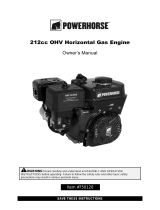
Page 10 of 35
Before Each Use
Improperly maintaining this engine, or failure to correct a problem before operation, can cause a
malfunction in which you can be seriously hurt or killed. Always perform a pre-operation inspection
before each operation, and correct any problem.
Pre-Operation Checks
For your safety, and to maximize the service life of your equipment, it is very important to take a few
moments before you operate the engine to check its condition. Be sure to take care of any problem
you find, or have your servicing dealer correct it, before you operate the engine.
Before beginning your pre-operation checks, be sure the engine is level and the engine switch is in
the OFF position. Always check the following items before you start the engine:
Check the General Condition of the Engine
1. Look around and underneath the engine for signs of oil or gasoline leaks.
2. Remove any excessive dirt or debris, especially around the muffler and recoil starter.
3. Look for signs of damage.
4. Check that all shields and covers are in place, and all nuts, bolts, and screws are tightened.
Check the Engine
1. Check the fuel level. Starting with a full tank will help to eliminate or reduce operating
interruptions for refueling.
2. Check the engine oil level. Running the engine with a low oil level can cause engine damage.
3. The Oil Alert system will automatically stop the engine before the oil level falls below safe
limits. However, to avoid the inconvenience of an unexpected shutdown, always check the
engine oil level before startup.
4. Check the air filter element. A dirty air filter element will restrict air flow to the carburetor,
reducing engine performance.
5. Check the equipment powered by this engine.
Review the instructions provided with the equipment powered by this engine for any precautions and
procedures that should be followed before engine start-up.



























